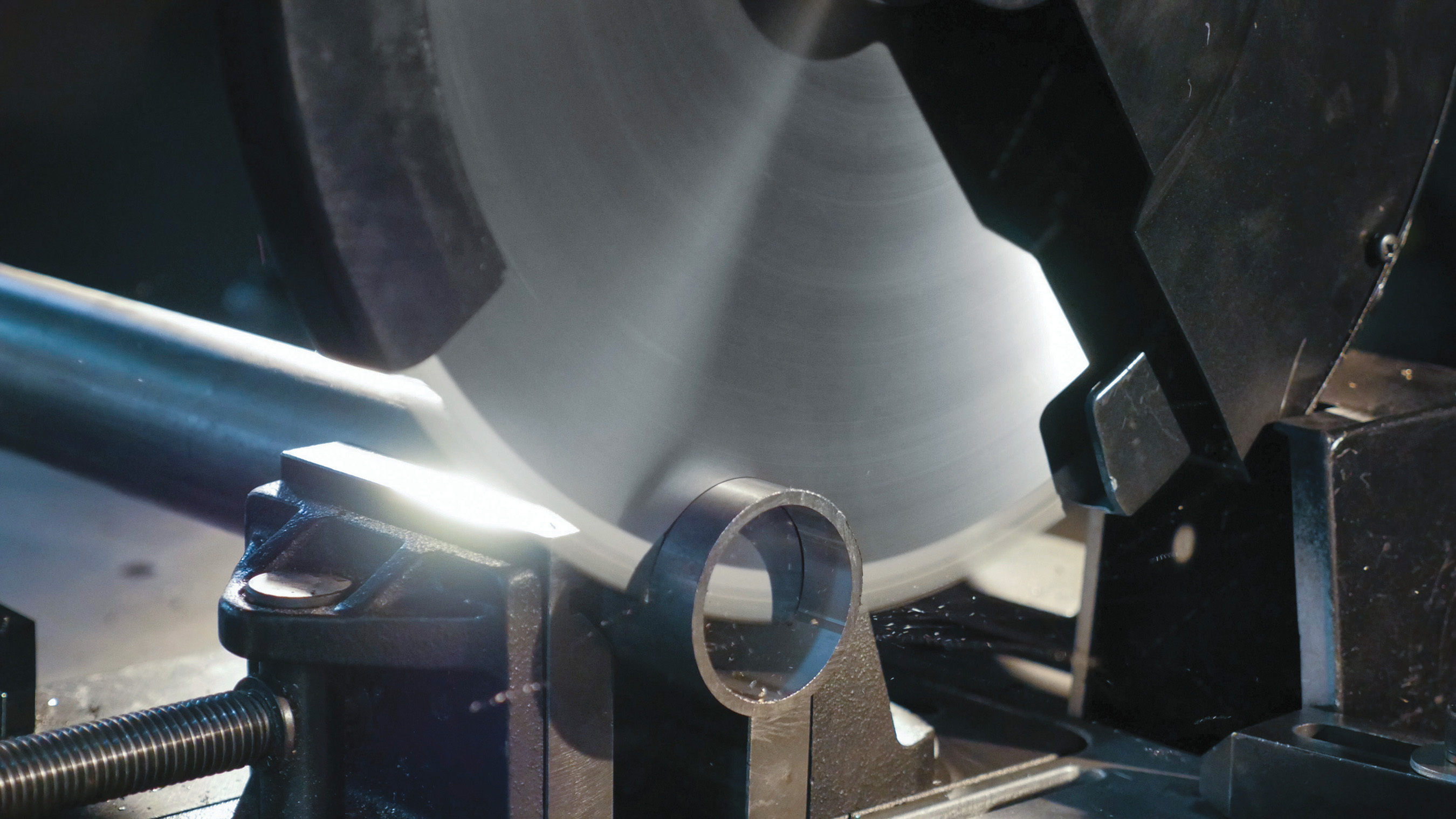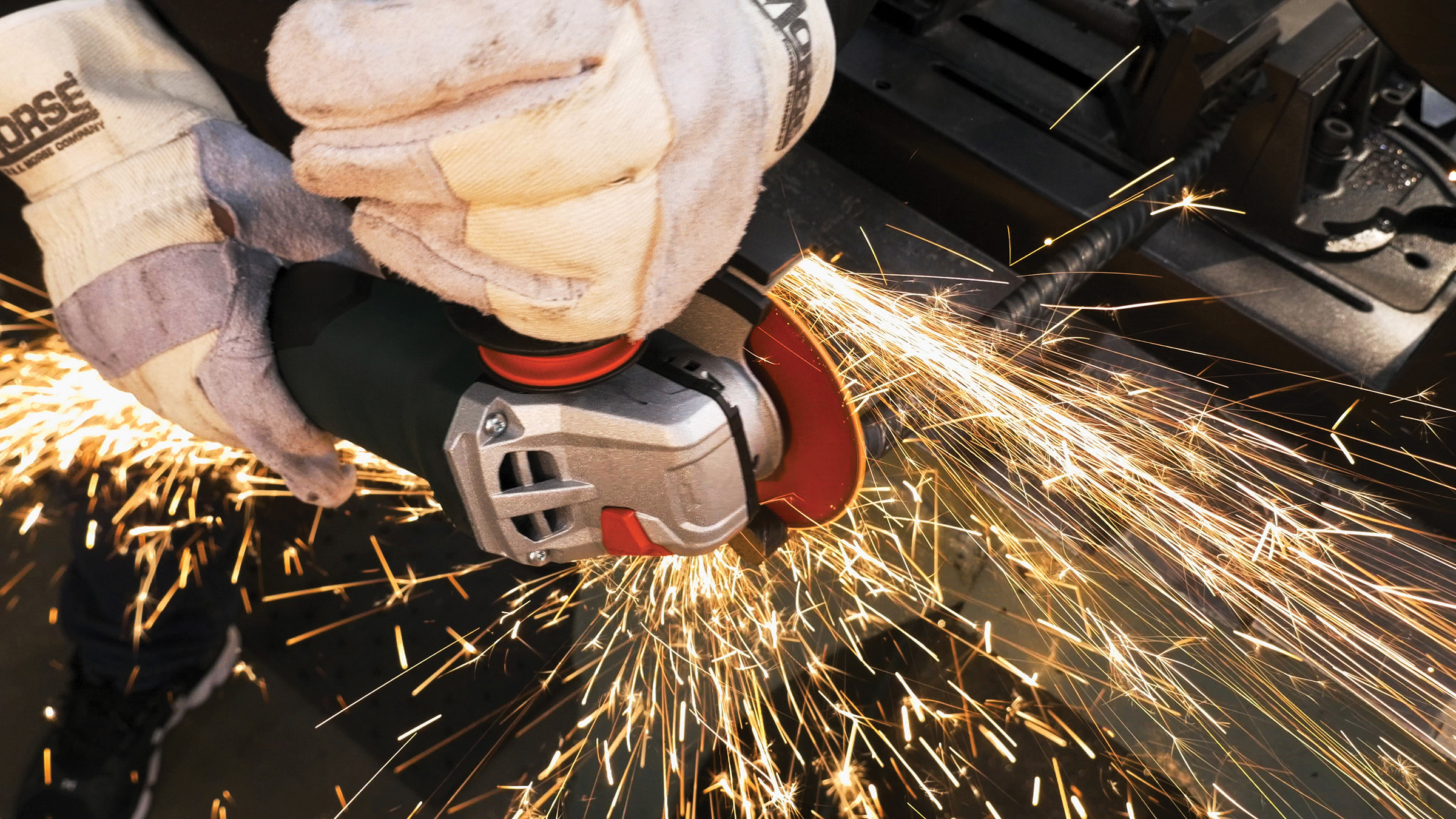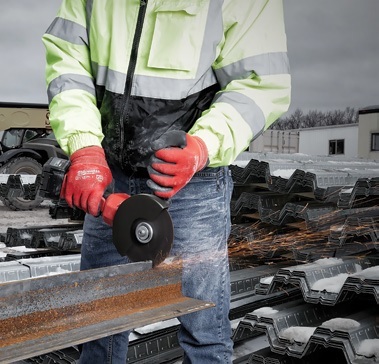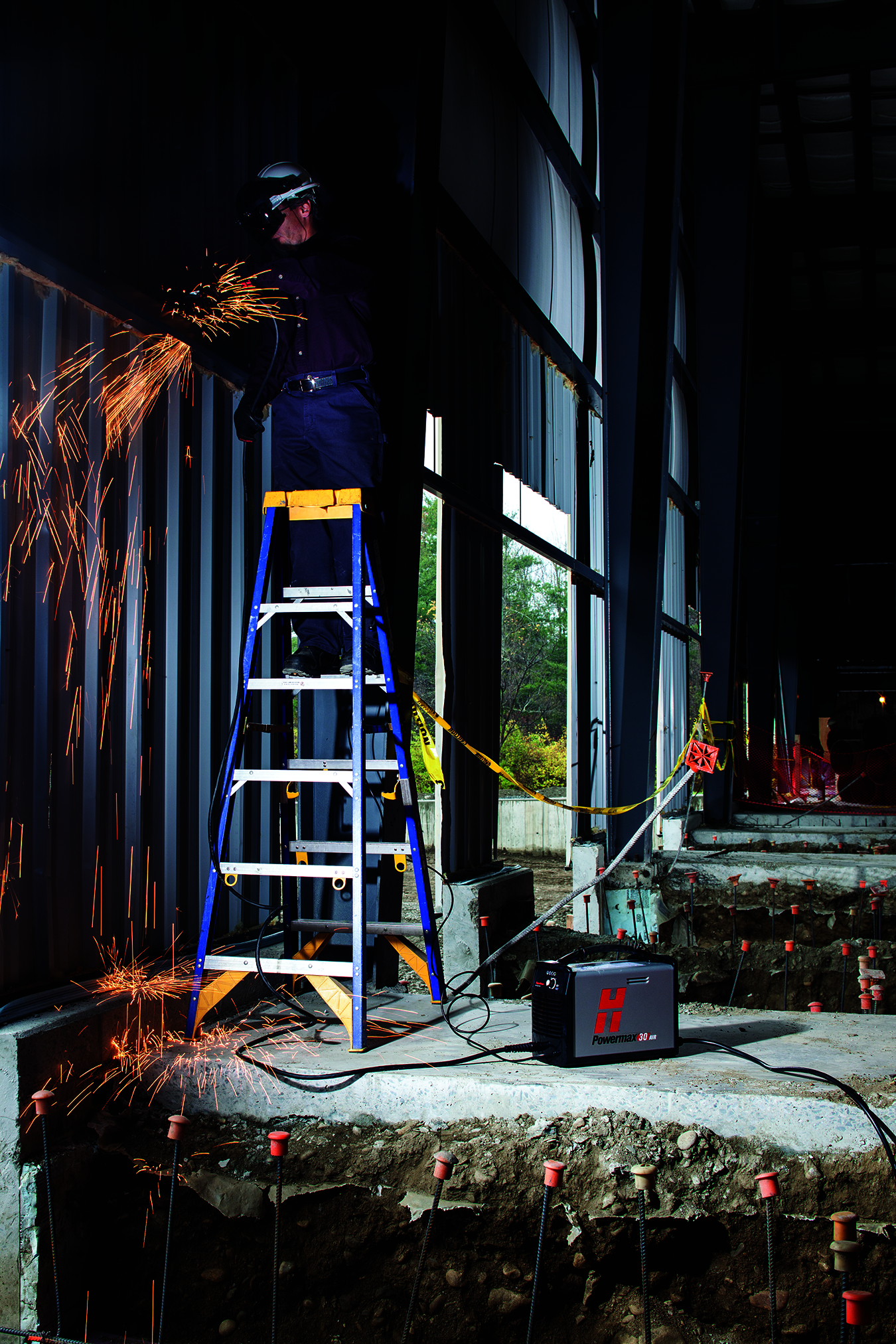A Cut Above
by Mark Robins | 3 May 2021 12:00 am
The correct tool will help you safely and successfully cut metal

(Photo courtesy of Bosch Power Tools North America)
Cutting metal adjusts it to the right size for a particular application or controls a surface for a better fit. This happens when cutting and hemming metal roof panels, shaping metal roof flashing, creating decorative trim and cutting structural support applications like I-beams and pipes. To create controlled, accurate cuts there are many portable power tool options available; the right tool depends on the project and the material being cut.
“Throughout the construction process, metal is used every step of the way—from the second concrete is poured to the last finishing steps,” says Brian Alves, group product manager at Milwaukee Tool[1], Brookfield, Wis. “The most used metal-cutting tools are grinders because they’re so versatile and relatively inexpensive, but bandsaws are also popular due to the clean and consistent cuts they make, as well as ease of use.”

(Photo courtesy of The M. K. Morse Co.)

(Photo courtesy of The M. K. Morse Co.)
“Most tools can be used to cut solids or pipes/shapes,” explains Bruce Woodruff, director of marketing at The M. K. Morse Co.[3], Canton, Ohio. “The primary differences relate to when they are best used and specialty applications where they excel.”
Jeff Hluchyj, marketing project manager at Hypertherm Inc.[4], Lebanon, N.H., has witnessed a transition from older methods like oxyfuel, carbon arc gouging and grinding to plasma cutting systems to cut metal that frames walls and ceilings; fabricates roof or floor trusses; and installs roofing, siding and decking. “Also, the systems are used to cut galvanized steel channels and corrugated steel panels to length, and for creating holes and openings for running conduit, installing vents, adding skylights, etc. The systems are also useful for jobs like beam coping, or for removing flanges and temporary attachments.”
Safety
Cutting metal is a dangerous job. Wear the correct PPE: gloves, eye protection, ear protection and proper footwear. Cover all exposed skin with gloves, a long-sleeve shirt and pants. Make sure that the work area is free of obstructions. Securely clamp metal before cutting it. Read the product instruction manual for the tool you are using; it provides the user the best understanding of the tool and how to stay safe while using it.

(Photo courtesy of Dynamic Fastener)

(Photo courtesy of Dynamic Fastener)
Once a cutting tool touches the metal, hot, sharp debris can be thrown into the air which could cut or harm the operator. But cutting tools are have been made with precautions to protect users. Woodruff says cut metal stays cool to the touch when cutting with a metal-cutting circular saw or chop saw blades, and steel body cut-off wheels reduce the danger of wheels flying apart during use, which can happen with traditional abrasive cut-off wheels. “Tools guards continue to improve operator protection, when they are used. Be sure guards are in place prior to operating any tool. If using a standard circular saw or chop saw with a metal cutting blade, while the cut material is cool, the chips are hot.”
One of Annandale, Minn.-based Malco Products[5] SBC’s product lines provides a low-fatigue method of cutting long or frequent cuts. “These tools attach directly to your cordless drill or driver to leave one hand available to hold material and steady the work piece,” says Jon Olson, market research analyst/mechanical-manufacturing engineer at Malco Products SBC. “The latest generation of our TurboShear Heavy Duty sheet metal cutting tools allows users to rotate the cutting edges to aid ergonomics.”
At Bosch Power Tools North America[2], Mt. Prospect, Ill., safety is factored into product development. “When it comes to metal circular saws, the biggest feature addition is the chip collection,” says Mitch Burdick, product manager at Bosch. “This helps keep potentially harmful metal shards contained and the work area clean. [For grinders] kickback control is a part of the tools’ electronics that helps shut the tool off if the blade gets in a serious bind. Drop protection helps shut a cordless tool off if the user drops the grinder during use. Brakes rapidly stop the wheels rotation when the trigger is released to prevent putting the tool down and having it unintentionally move while the wheel is spinning. Anti-vibration handles or low-vibration construction improves comfort in all-day applications. Compact band saws provide smaller, lighter tools for better control when cutting overhead. Cordless tools—especially cutting tools—have a lock-out switch that helps prevent accidental tool start when battery pack is left on the tool.”
At Hebron, Ky.-based Tenryu America Inc[6]., national sales manager, Keiji Iida, says his company stresses cutting safety with smaller bases, a smaller opening on the base, a well-covered housing over the sawing unit, an electric brake and a slower RPM speed.

(Photo courtesy of Milwaukee Tool)
Newer plasma cutting systems come with safety triggers to prevent an operator from accidentally triggering the plasma arc before they are ready to cut. “Generally, plasma systems are much safer than alternative metal cutting tools you might use on a job site since air plasma systems use compressed air, rather than a flammable, explosive gas like acetylene,” Hluchyj says.” Compared to grinders, plasma is safer because it does not cause the ergonomic injuries from vibrations you see with grinding. You also do not have to worry about a disc shattering and flying up into your face.”
Improvements
Safety isn’t the only improvement happening in metal cutting tools. Historically, the job site has been limited by extension cords and access to power. Now, cordless versions of cutting tools provide great utility on-site due to the limited supply of power sources. “We’re also finding that, due to our advancements in lithium-ion, electronics and motors, these cordless versions are meeting and surpassing the performance of their corded predecessors,” says Derek Rose, director of product marketing at Milwaukee Tool. “These cordless options also eliminate the hassle of maneuvering around cords and give users the freedom to be more productive.”
Burdick says cordless cutting tools have increased both in power and battery run time due to improvements in tool design, and battery cells/number of cells per pack and battery construction. “With electronic boards and brushless motors, handheld power tools are becoming smaller and more compact, yet achieving equal or even better power and performance versus their corded counterparts.”
Blade design improvements have increased cut speed and blade life. However, Woodruff cautions certain tool improvements, including higher RPMs or faster stroke speed, actually reduce blade life when cutting metal. “For optimal cutting performance and blade life, refer to blade manufacturer recommendations for operating parameters.”

(Photo courtesy of Hypertherm Inc.)
Ken Webb, sales manager at Dynamic Fastener,[7] Kansas City, Mo., says nibblers are eliminating the tools needed to change the punch or die. “There is no set screw on the die as with older models, instead [you] unscrew by hand the collar around the die to replace.”
Even cutting-tool grips have improved. “The classic grips many of us grew up using have been replaced with new modern grips,” Olson says. “The PowerFit Grips on the Malco AVs help users power through material with less hand fatigue.”
Hluchyj says plasma cutting systems have gotten smaller and lighter making it easier to bring them to job sites, and they are more powerful so crews can cut thicker metal. “There are also a range of new specialty items that allow operators to cut in tight corners, flush cut and have more control when gouging. We even have a 6-foot-long plasma torch which is really cool because it makes it easier to cut something up above you or on the ground without having to bend down.”
Mistakes
Alves and Rose concur using the wrong tool is the most common mistake made in metal-cutting applications. They advise, “Users need to look at the type of metal, metal thickness, desired direction of cut, and the amount of material that needs to be cut. From there, they will be able to determine if a manual or battery-powered tool is the right solution and, if powered, they can also select the proper blade or accessory.”
Webb agrees that a common mistake is not using the proper nibbler or shear for the gauge of material being cut. “Nibblers can be used to cut flat or corrugated sheet metal, and shears are only used for flat sheets,” he says.
Iida contends there is no dream tool for cutting everything explaining, “There are some saws for ultimate DIYers, heavily advertised as a must-have in the garage. Those saws are not professionals.” He also stresses choosing the correct saw blade. “There is no one-blade-does-all saw blade. Cutting with a wrong blade, or a saw, may result in short life, inferior cut quality, damaging the material to waive the warranty or even injury. Many contractors call Tenryu for consultation. Not only for what saw blade to use, but we can advise the right tool to use.”
Another common mistake is for users to try to make the tool work faster or harder than it was intended or designed for. “Regardless of the application, the user should always let the tool do the work and gently or with only moderate force guide the tool along,” Burdick says. “Users can also commonly try to make their tools do one more application to get a job done at the end of the day to stay on track, usually when they are tired. In this case, it is probably better to either take a short break, assess the situation and proceed with a little more caution to avoid mistakes or avoid putting themselves at risk during the application or prepare to finish up and plan for the next day.”
Olson believes the most common metal cutting tool mistakes relate to the angle the snips—hand-powered or power-assisted—are held relative to the material being cut and selecting tools with improper gauge capacity. “For material to flow smoothly through a snip, the tool must be leaned towards the upper cutting edge. This lean is natural for many, but can frustrate others. Most struggling to realize the full potential of a snips need to add a slight lean to the snip, as this aligns the cutting edges. Failing to align the cutting edges leads to the blades splaying open or requiring adjustment. Next time you cut a piece of material, try leaning the snip towards the upper blade, which may make it easier to cut your workpiece.”

(Photo courtesy of Malco Products SBC)
- Milwaukee Tool: http://milwaukeetool.com.com
- Bosch Power Tools North America: https://www.bosch.com/
- The M. K. Morse Co.: http://mkmorse.com
- Hypertherm Inc.: https://www.hypertherm.com/en-US/
- Malco Products: http://www.malcoproducts.com
- Tenryu America Inc: http://tenryu.com
- Dynamic Fastener,: http://dynamicfastener.com
Source URL: https://www.metalconstructionnews.com/articles/a-cut-above/